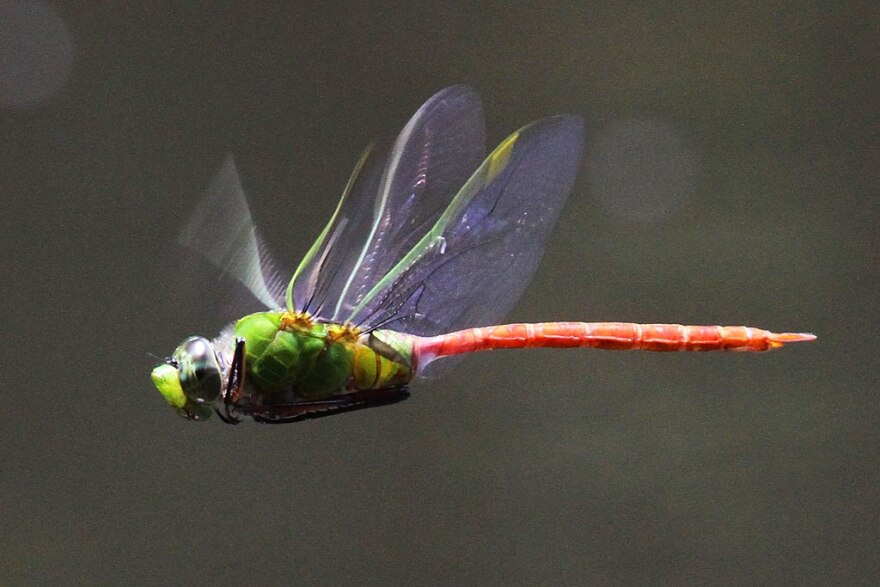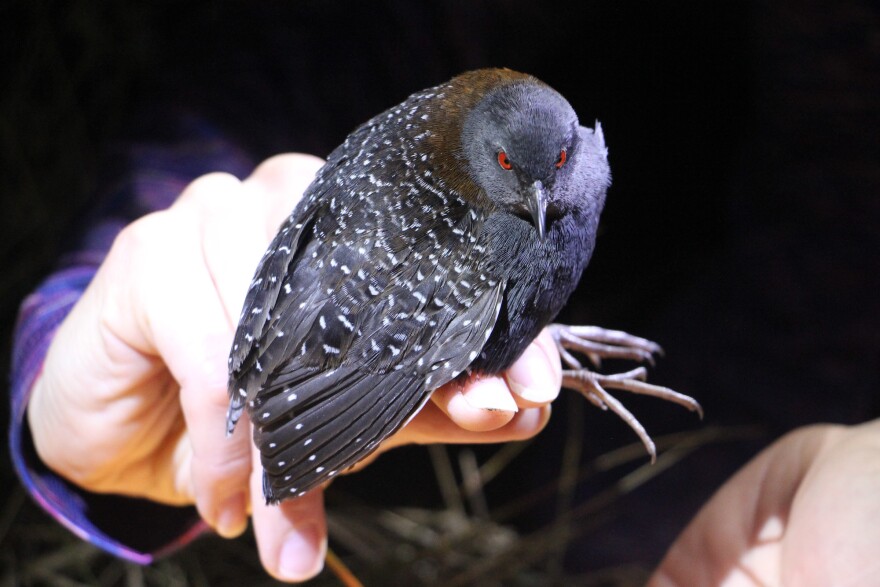As rising seas, coastal development and invasive species make it increasingly hard for Delaware’s native animals, fish, plants and insects to survive, Steve Cottrell may have found a way of reversing the decline of one bird species in his own back yard.
Cottrell, president of the bird-conservation nonprofit Delaware Audubon, has built five 14-foot towers made of lumber and set in concrete for chimney swifts to nest in the yard of his home near Newark. The idea is to provide the birds – summer migrants that feed on insects while swooping around the sky – a place to raise a brood at a time that many people are capping the chimneys where the birds traditionally nest.
This summer’s result so far: for the second year in a row, five pairs of chimney swifts have nested, and each “chimney” had nests with eggs but as of July 1, none had fledged young. Last year, the towers produced 19 fledglings.
For chimney swifts at least, Cottrell’s individual action appears to have held back an ongoing decline in the number of species that used to inhabit Delaware in greater numbers than they do now, and are finding it increasingly hard to live and breed successfully in the state.
That’s the conclusion of the new edition of the Species of Greatest Conservation Need, an accounting by the Division of Fish and Wildlife at the Department of Natural Resources and Environmental Control of six categories of species found in Delaware. Each species is ranked according to the perceived urgency of its need for protection. The report covers birds, fish, invertebrates, mammals, reptiles and amphibians, and for the first time, plants, which have swelled the overall list from some 700 to about 1,000 species of all kinds.
“Most species over the past decade are probably in more need of conservation than not. The continuous whittling away of wildlife habitat is a big driver in why we have state action plans that show deterioration in the status of some species.”Greg Shriver, professor of ornithology at the University of Delaware
The report suggests there’s little individuals can do to reverse an overall decline in natural species, but Cottrell welcomed it as a sign that state officials are at least watching. “It’s good for people to know that there are folks in Delaware who are paying attention,” he said. “It’s up to individuals to contact their lawmakers. There might be some small areas where you can make an impact.”
The chimney swift is ranked at tier 1, the highest level of conservation need, up from tier 2 in 2015, the last time the report was published. The bird’s elevated status reflects its inclusion on a ‘red list’ of threatened or endangered species published by the International Union for Conservation of Nature.
The eastern meadowlark, a declining grassland species, is also elevated -- to tier 2 from tier 3, reflecting its status as a bird for which Delaware has special responsibility within the Northeast region. But the bobolink, another bird that breeds in grassy fields, and is the subject of conservation campaigns elsewhere, has been downgraded a notch to tier 3, reflecting its status as a migrant rather than a breeding bird in Delaware.
Many fish have been moved up to the highest level of conservation concern. They include the spinner, black tip and bull sharks, each of which have been moved up from tier 2 in the last report. Bluefish also are now assigned the highest level of conservation concern, up two tiers in the last 10 years.

Among invertebrates, the American bumblebee stays at the highest tier, while the comet darner, a kind of dragonfly, is elevated to tier 1 from tier 3. The Delaware skipper, a butterfly, descends a notch to tier 3.
Even though some species have been downgraded or even exited the list, most now have a higher conservation concern than they did 10 years ago. That commonly reflects habitat loss driven by the effects of climate change; development of coastal and inland areas which is encouraged by municipalities seeking the economic benefits of more housing or businesses; the rapid growth of invasive species of plants and fish, crowding out the native species that feed wildlife, and the pollution of critical areas.
“Most species over the past decade are probably in more need of conservation than not,” said Greg Shriver, a professor of ornithology at the University of Delaware, and a contributor to the report. ”If it’s more lucrative to put a housing complex or an Amazon distribution center or a Wal-Mart, those are all places that used to support birds. The continuous whittling away of wildlife habitat is a big driver in why we have state action plans that show deterioration in the status of some species.”
Among Delaware’s rarest birds is the black rail, a secretive marsh dweller that has very specific habitat requirements, and so is exceptionally sensitive to the flooding of coastal marshes that comes with sea-level rise. There may be just one breeding pair left in Delaware, reflecting a catastrophic regional decline of more than 90 percent since the 1990s, Shriver said. On the new list, the bird’s status is level 1, unchanged from the last report. The black rail is listed as endangered by the State of Delaware.

But some species seem to be doing better than they did 10 years ago. For example, the big brown bat was removed from the list because it was found to be more abundant than previously thought, and is not susceptible to white-nose syndrome that’s killing other bat species.
Samantha Robinson, a DNREC environmental program manager who heads the report, said it’s designed as an information source for the whole conservation community including nonprofits and federal agencies.
It’s not easy to stop the loss of habitat, but the state can seek conservation easements – in which a landowner agrees in perpetuity not to develop a parcel – or seek to protect coastal areas where marshes can move inland as seas rise, Robinson said. That process can be stopped by the “hardening” of coastlines with jetties, bulkheads or riprap – lines of large boulders.
There may be some changes to the list as a result of the current public-comment period but they are unlikely to be numerous, Robinson said.
Creation of the list makes Delaware’s Division of Fish and Wildlife eligible for matching federal funds but those are in doubt this year because of deep cuts to many environmental programs by the Trump administration, Robinson said.
For the 2015 report, Delaware received $459,950 through a program run by the U.S. Fish and Wildlife Service, and has been allocated $552,727 for 2025 alone. If any of the funding is declined by Congress, several research and monitoring projects could be funded from other federal or state sources but some of those projects would not be eligible for federal funding, Robinson said.
In early July, it was still unclear whether Delaware would receive federal funding for its species-conservation program, said DNREC spokesman Michael Globetti. “DNREC’s understanding is the House budget has not yet released the funding proposed for State Wildlife Grants – we are still waiting to hear the future proposed budget from either budget version,” Globetti said on July 2.
UD’s Shriver predicted that federal funding for SGCN will be less this year -- although it is unlikely to be zero – reflecting the Trump administration’s anti-environmental agenda. “What’s happening in Washington now is basically a gutting of anything environmental or conservation based,” he said.
If federal funding is cut for conservation, it could have a big impact, for example, on Delaware’s support for an annual program that monitors bird migration through the Delaware Bay, an internationally important stopover for migrating shorebirds, Shriver said.
He agreed with the inclusions and their rankings, which he said reflect an overall decline in the abundance of wildlife, plants, fish and insects. The list is the latest indication, he said, of a decline that began in the early 2000s when he was leading field-ornithology classes in the Adirondacks, teaching students how to identify the song of less-familiar species amid a chorus of common birds.
Some 12 years later, at the same site, there was simply no bird song to be heard, he said. “By the last year I did it, we would stand there and wait and not hear any birds singing. So I had that moment, when I thought, ‘This is my new normal.’”
"Habitat loss and climate change are the biggest two [issues] right now. But there’s very little a small state like Delaware can do to change that.”Delaware Audubon president Steve Cottrell
Now, the new list reminds conservationists that there are still battles to be fought even if the odds appear heavily stacked against the survival of species like the black rail, Shriver said. “We think that is the first species that has really winked out because of the hydrologic changes caused by sea-level rise. It’s the species that has declined the most in the Mid-Atlantic, Delaware Bay included,” he said.
For the new report, the Delaware FWS is creating a live database that will allow public users to search for a species, look at threats and actions to defend it, and examine maps. The new system will replace a pdf that required users to scroll through to find information, and was seen as less user-friendly. “We’re hoping this is a much more usable format for everyone in Delaware,” Robinson said. The rebuilt website is expected to go live in July or August.
The public was invited in mid-May to comment on the draft. The public comment period will end a month after the report is finalized which is expected in August or September.
Despite his success in providing a haven for breeding chimney swifts, Cottrell of Delaware Audubon is skeptical about how much the new list can do to protect the species it identifies.
“There’s a lot of birds on Tier 1, and there’s only so much people can do,” he said. “Habitat loss and climate change are the biggest two right now. But there’s very little a small state like Delaware can do to change that.”
Asked whether the list is a microcosm of a worldwide decline in wild species, leading to extinction in the worst cases, DNREC’s Robinson said it’s a warning that conservationists have a major challenge ahead of them.
“If you are looking at over 1,000 species just in the small state of Delaware that we have identified as needing conservation to prevent them from becoming extinct or becoming more rare, then definitely,” she said.




